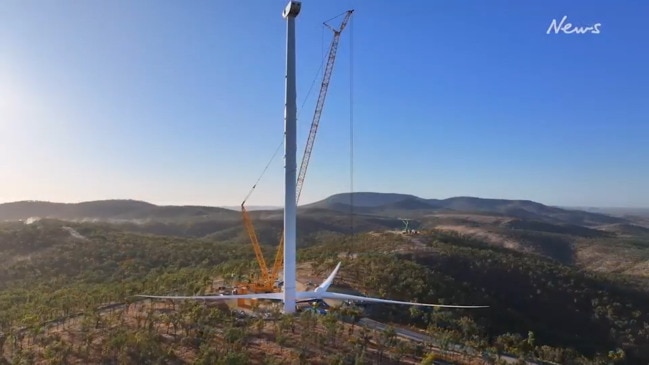Government earmarks six projects for offshore wind-powered electricity generation licence
Federal Energy Minister Chris Bowen is considering giving six developers a licence to generate electricity from wind-powered turbines off the Victorian coast.

Business
Don't miss out on the headlines from Business. Followed categories will be added to My News.
The federal government has earmarked six Gippsland offshore wind-powered electricity generation projects for licences, as authorities move to accelerate development of an industry widely seen as critical to cushion the impact of the retirement of coal-fired power.
Some of the world’s largest renewable energy developers and local giants last year lodged applications to develop offshore Gippsland, moving to capitalise on Victoria’s plan to use the zero emission source as a major replacement for coal.
Authorities received 37 development proposals, which federal Energy Minister Chris Bowen has now whittled down. A total of six projects are under preliminary consideration for a so-called feasibility licence, with another six moving through an overlapping process where would-be developers work with rivals to see if boundary disputes can be resolved. The remaining 25 projects have been preliminarily rejected.
A final decision on who receives the development licences is now expected around February after consultation with Indigenous groups.
The government did not reveal the identities of the six projects on course for a licence, but said that if all were established there would be 12GW of new capacity in Australia’s energy network.
It is not clear how many licences the government intends to award, with market sources indicating that six was high and may indicate a belief that not projects awarded a feasibility licence will be established.
The Australian understands that developers have been told of the decisions, but told to keep the information confidential.
The preliminary decision of the Energy Minister comes after the Offshore Infrastructure Registrar evaluated applications according to criteria issued to the market in 2022, which included evidence of capital and previous experience. But the regulator said it could struggle if projects were of similar merit criteria and were seeking the same part of the permitted region.
Feasibility licences give projects exclusive rights over a part of the region for seven years, which is critical for attracting investment.
Likely successful applicants are Star of the South, backed by Danish fund Copenhagen Infrastructure Partners and superannuation fund Cbus, and Corio, the green energy developer owned by Macquarie.
Star of the South is most advanced, having completed significant preliminary works, which will be invaluable if Victoria is to meet its ambitious climate goals.

The Victorian government in 2022 set a target of generating the equivalent of about 20 per cent of its energy needs from offshore wind within a decade. The target then doubles to 4GW by 2035 and 9GW by 2040. In all, Victoria sees potential for 13GW of offshore wind capacity by 2050, five times the current renewable generation in Victoria.
Victoria’s coastline is ideal for offshore wind. Winds are very strong and consistent by international standards, while a large area of shallow ocean less than 50m-60m deep is suitable for wind turbine platforms to be fixed to the seabed, a much more mature and cheaper technology than the floating turbines that have to be used in deeper waters.
Offshore wind proponents have been heightening pressure on officials to name the preferred developers amid rising global competition.
The US, Europe and China are rapidly expanding their offshore wind industries to meet decarbonisation targets, and industry executives fear Australia could be left behind.
Delays would be particularly serious for Victoria. Victoria is one of Australia’s most coal-dependent states. The Australian Energy Market Operator expects all coal generators to retire within 15 years, and offshore wind is seen as the only type of generation with the scale to be able to replace the traditional source of electricity.
Unsuccessful developers could move elsewhere, most notably to NSW, but that would require the installation of floating wind turbines, which remain some years behind the established technology of fixed platforms.
Still, moving into NSW would allow developers to capitalise on strong demand from Australia’s most populous state and projects could re-use existing infrastructure from retiring coal power stations. AGL Energy’s Liddell coal power station closed last April and its Bayswater coal-fired power station is due to shut no later than 2033.
More Coverage
Originally published as Government earmarks six projects for offshore wind-powered electricity generation licence





